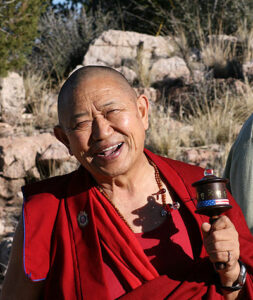Fire Flame Meditation – H.E. Garchen Rinpoche
Translated by Ina Bieler
Om Ah Hung, Om Ah Hung.
When we meditate, we look at our mind. When looking at the mind, what are we looking at? We are looking at our thoughts. When you look at your thoughts, there is an awareness that recognizes these thoughts.
What is the benefit of looking at our thoughts? We have to find the awareness that sees thoughts. According to the Dzogchen teachings, this awareness that sees thoughts is called “the lamp of self-arisen, knowing awareness”. The metaphor of a lamp is used. The Samantabhadra Prayer speaks of the “lamp of awareness”. To me, when I meditate, this lamp here has a natural connection to the mind. This is because a beginning meditator, at times, might not have any coarse thoughts, and only subtle thoughts – the base consciousness – that remain unrecognized, but arise uninterruptedly.
They are like the sound naturally emitted by a flame of fire. This is also how the sound of mantra emerges; it is the self-resounding sound of nada. A sound emerges from the flickering of the flame. In Secret Mantra this is called the “indestructible self-sound of nada”. In any case, when we meditate, where is this flame? The flame is a quality of the wind when they abide at the navel. In the little Samantabhadra book, I added a flame to the image of Samantabhadra yab-yum. What is meant by the “navel”?
In the centre of the body in front of the spine, directly at the navel level, there is the place where the winds dwell. It is the navel chakra, which stems from the central channel. Why do the winds abide there? The body was first created through warmth – the subtle essence of the mother, or the red drop. This warmth remains until the life force is exhausted; it is the life-sustaining wind. The warmth sustains life-force. The life of a person depends on warmth. What we call “life” is consciousness that is not separated from warmth. The essence of the winds is warmth. Through the Secret Mantra practices of the channels, winds, and drops, the winds are brought to always abide at the navel.
Even Western scientists recognize the benefits that holding the winds at the navel has for athletes. Whether one is Buddhist or not, it is said that the navel is the dwelling place of the winds. Meditating on the flame is a method for the mind to become clear. In order for the mind to abide at the navel, visualise a HUM syllable inside the flame. This HUM resounds with its own sound. HUM, HUM, HUM, HUM, HUM, HUM.
The sound of mantra emerges from this self-sound of nada. When you only mediate on the HUM, the HUM guards against thoughts. When thoughts are absent, it is alright not to recollect the HUM. There is a natural sensation like this black shadow inside the flickering flame. Even when you do not recollect the HUM, – like the black shadow being invisible for just a moment – the flame around is extremely clear. The shape of the flame remains uninterrupted. This is awareness. As your mind abides within the essence of intrinsic awareness, awareness sees all thoughts. This is the awareness that recognizes thoughts. And when there are no thoughts at all, that awareness is aware of itself. Thus, it is referred to as “self-aware, innate awareness.” The mind that is completely clear, without a single thought is the clear nature. This clear nature is empty, and the nature of emptiness is clarity. We can clearly see it, based on this outer analogy of this candle flame.
My explanation of the crucial point of practice for my disciples who are practitioners is based on this outer analogy from my own personal experience. When beginning practitioners meditate, at first even if there are no thoughts in the mind, their mind is still not very clear. When they continue to meditate for a longer time, sometimes the mind becomes completely clear, naturally like this flame.
Sometimes suddenly, instantly the mind is completely clear. This experience will eventually arise. It arises from the power of compassion for sentient beings or from the power of giving rise to faith in the Three Jewels. At that time, the mind is naturally very clear, like the bright shadow of the flame. When you have habituated to this for a very long time, you will not have any more questions to ask anyone else. You will have resolved it yourself, “I have understood the view”. You will be free of dualistic grasping. This is the lamp of self-arisen, knowing awareness”. This knowing awareness is also referred to as “primordial wisdom”. In the Dzogchen instruction texts, the view is explained as the “lamp of primordial wisdom,” or the “torch of certainty”.The outer example of this lamp is a flame, something that we can actually see.
Those who are skilled in explaining practice should consider using this example in their teachings. Those who meditate should look at their mind. The mind will not always be constantly clear. But sometimes when you meditate, the mind becomes like the clear light of this flame. Sometimes the mind becomes clear for a short while. When this happens, it is important to recognize it. Once you have recognized it, by habituating it again and again, you will become free of dualistic grasping, free of all grasping. This is called “awareness recognizing itself,” or actually “self-knowing, innate clarity.” No one illuminates this flame here, it is self-illuminating; its clarity and emptiness are inseparable. This is how it will become. You have to use this analogy and apply it to your inner mind.
When you meditate, first, all the coarse thoughts disappear and the mind is able to abide in stillness. At this point, clarity has not yet arisen. You continue to meditate again and again. When there are thoughts, focus on the HUM. Vibrating with your natural pulse: HUM, HUM, HUM, HUM, HUM, just like the flickering of this flame. The dark inside shadow is ignorance. It is co-emergent ignorance. In actuality, there is no ignorance, but in the Samantabhadra Prayer, ‘co-emergent ignorance” refers to the inability to see the nature of mind as it is, without any doubt. It is unawareness. When you meditate and the mind is clear, it flickers a bit, just like this flame.
Sometimes you recognize clear awareness for a moment. What is the merit of recognizing clear awareness? As I mentioned before, you become free of doubt with regard to the nature of mind. Due to the opportunity [to use this lamp to illustrate my teaching] today, I gained an understanding. But also, before this I have used the image of the flame on many occasions as an example of self-arisen awareness. For this reason, we should meditate on a flame at the navel. The wick of a butter lamp is the syllable HUM. Some cannot visualize the syllable HUM, because to them it is a conceptual elaboration. But what is important is the sound HUM – it doesn’t matter in which script, it can be in Chinese, Tibetan or English. Later you do not even have to meditate on the syllable anymore. You can just meditate on the sound HUM, appearing naturally as the vibration of your pulse. At that time, when you vibrate with HUM, HUM HUM, even the subtlest of thoughts are quelled and the natural brightness and clarity of your mind will be revealed naturally. This has helped me be more diligent in my own practice.
I have added it to the image in the Samantabhadra Prayer because people often wonder where to visualize the HUM. Whether you are visualizing the yab or the yum, the HUM is visualized at the navel level, at the centre of your body, in front of the spine. On the outer level, there are two, the yab and yum [male and female]; but within the mind, the yab is the natural clarity and the yum is the empty nature. In the mind that is free of all thoughts, there is no separation between yab and yum. It is taught that yab and yum are indivisible, appearance and emptiness are indivisible.
First appearances is the yab and emptiness is the yum. Secondly bliss is the yab and emptiness is the yum. And when you actually recognize the natural state of mind, clarity is the yab and emptiness is the yum. So, first there is appearance-emptiness, then bliss-emptiness and finally clarity-emptiness. And to recognize the emptiness of clarity is to recognize the emptiness of awareness. It is empty awareness – the vajra mind. The very essence of awareness is like the bright outer shadow of the flame. Abiding in it uninterruptedly is called “non-meditation”. It is. when meditation has become stable.
This is why I have added the outer example of the flame [to the Samantabhadra image, just like this clear flame. It is truly profound, it comes from personal experience. It is an excellent way to illustrate an inner experience through an outer analogy. Therefore, I offer it to my dharma friends like a mandala offering. Tashi Delek to all my dharma friends. I pray that the ultimate precious supreme bodhicitta may arise in your mind stream.



